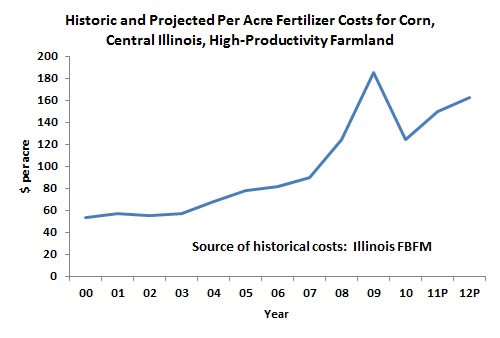Forward Contract Delivery Prices Point to Higher 2012 Fertilizer Costs for Corn
In its July 7th report, the Agricultural Market Service reports fertilizer contract prices for fall delivery as $814 per ton for anhydrous ammonia, $688 per ton for Diammonium Phosphate (DAP), and $627 per ton for potash. Using these fertilizer prices too calculate 2012 fertilizer costs grown on high productivity farmland results in $162 per acre. The $162 per ton projection is above 2010 and 2011 costs, but below 2009 costs.
The $162 per acre fertilizer cost projection for 2011 is calculated using application rates of 180 pounds per acre of anhydrous ammonia, 170 pounds for DAP, and 85 pounds for potash. These application rates are based on University of Illinois agronomic recommendations, with phosphorus and potassium applied at replacement rates. The expected yield used in calculating nutrient needs is 195 bushels per acre.
If actual costs in 2012 equal projected costs, the $162 per acre costs will be the second highest on record for central Illinois farms with high-productivity farmland (see graph below). Only the 2008 cost of $185 per acre exceeds the 2012 projected costs. The actual fertilizer cost of $124 in 2010 and the projected of $150 per acre for 2011 are below the projected 2012 costs.

In recent years, fertilizer costs have generally increased. In 2002, fertilizer costs were $57 per acre. From the 2002 level, fertilizer costs increased $35 per acre, reaching $90 per acre in 2007. Since 2007, fertilizer costs have been above $100 per acre. Fertilizer costs reached $124 per acre in 2008, a $34 per acre increase over 2007 costs. Costs increased another $61 per acre and reached the high of $185 per ton in 2009.
Much of the very high 2009 costs can be attributed to high fertilizer prices during the fall of 2008, the period in which much of fertilizers purchased for 2009 were purchased. From highs in 2008, prices fell steadily resulting in lower costs of $124 per acre in 2010. Fertilizer prices began increasing in 2010, resulting in higher costs in 2011 of $150 per acre. Prices have continued to rise in 2010.
Actual costs will vary from the $162 per acre estimate, primarily due to changes in fertilizer prices. A feel for this variability can be gained by looking at changes in anhydrous ammonia prices. The contract delivery price for fall delivery in July 2008 was $500 per ton higher than the April 2009 cash delivery price. The summer contract price in July 2009 for fall delivery was $120 per ton lower than the April 2010 price. The contract price in July 2010 for fall delivery was $215 higher than the April 2011 cash price. Over these three years, the contract price was $500 higher, $120 lower, and $215 lower than the April price. These changes have impacts on costs. Each $100 increase (decrease) in anhydrous ammonia price increases per acre fertilizer costs for central Illinois high-productivity farmland by $9 per acre.
At this point, contract fertilizer contract prices point to higher per acre fertilizer costs. While fertilizer prices have changed over time, it is not likely that fertilizer price declines will lead to per acre costs below 2010 and 2011 levels. Higher fertilizer costs continue the trend of higher production costs for corn, leading to higher break-even corn prices necessary to cover costs.
Disclaimer: We request all readers, electronic media and others follow our citation guidelines when re-posting articles from farmdoc daily. Guidelines are available here. The farmdoc daily website falls under University of Illinois copyright and intellectual property rights. For a detailed statement, please see the University of Illinois Copyright Information and Policies here.







